Having a pet is always an exciting experience. Be it a dog, cat or even a fish, the responsibility is fun to get started with. However, as small and easy taking care of a fish might look, things are a tad bit different.
In order to start with a home aquarium, you need to know the basics, know what kind of fish you can start with and then purchase one. Typically, most beginner aquarists look for easier fish species to start with. And, the best ones are the ones that don’t need filters.
Wondering what it means?
It simply means that you can keep them in fish bowls and follow the staple care guides to keep them in optimal health.
But, which species fall into that category? Well, this article should give you a rundown of some of the best fish species that don’t need filters.
Table of Contents
Fish That Don’t Need Filters
- Betta Fish
- Guppy Fish
- Zebra Fish
- White Cloud Mountain Minnow
- Endler’s Guppies
- Dwarf Puffer Fish
- Pygmy Corydoras
- Sparkling Gourami Fish
Why are Fish Bowls more Convenient?
Not just for beginners, even advanced aquarium hobbyists rely on fish bowls for some fish. But, we as humans, always need concrete benefits to solidify our beliefs.
Don’t worry, we got you!
Here’s a quick rundown of why fish bowls are more convenient, especially if you have less space and a tight budget.
Smaller Size
They are smaller. It goes without saying that the size and shape of a fish bowl is comparatively smaller than a full-blown aquarium. This makes it easier to keep them in places that have less area.
Besides the space-saving feature, the smaller size also ensures quicker water change. You can safely transfer your fish, empty and clean the bowl and then reintroduce them to the clean water again. Everything happens in a breeze.
More Affordable
As we said before, budget is often a concern for some beginner aquarists. If you are one of them, a fish bowl is a good starting point. Fish bowls are available even in less than $10, enabling anyone to access them despite their budget.
Ideal for Single Species Tanks
If you don’t have a lot of experience with fish species, a fish bowl can be your stepping stone. It allows you to house same-species fish in a bowl. You can even keep solo fish if they do well on their own.
Popular Fish that Don’t Need Filter
Now that you have a fair idea of the importance of a fishbowl and lacking water filter, it is time to get to the crux of the article.
After much research and proper evaluation, we narrowed our list to the top 8 fish species.
1. Betta Fish
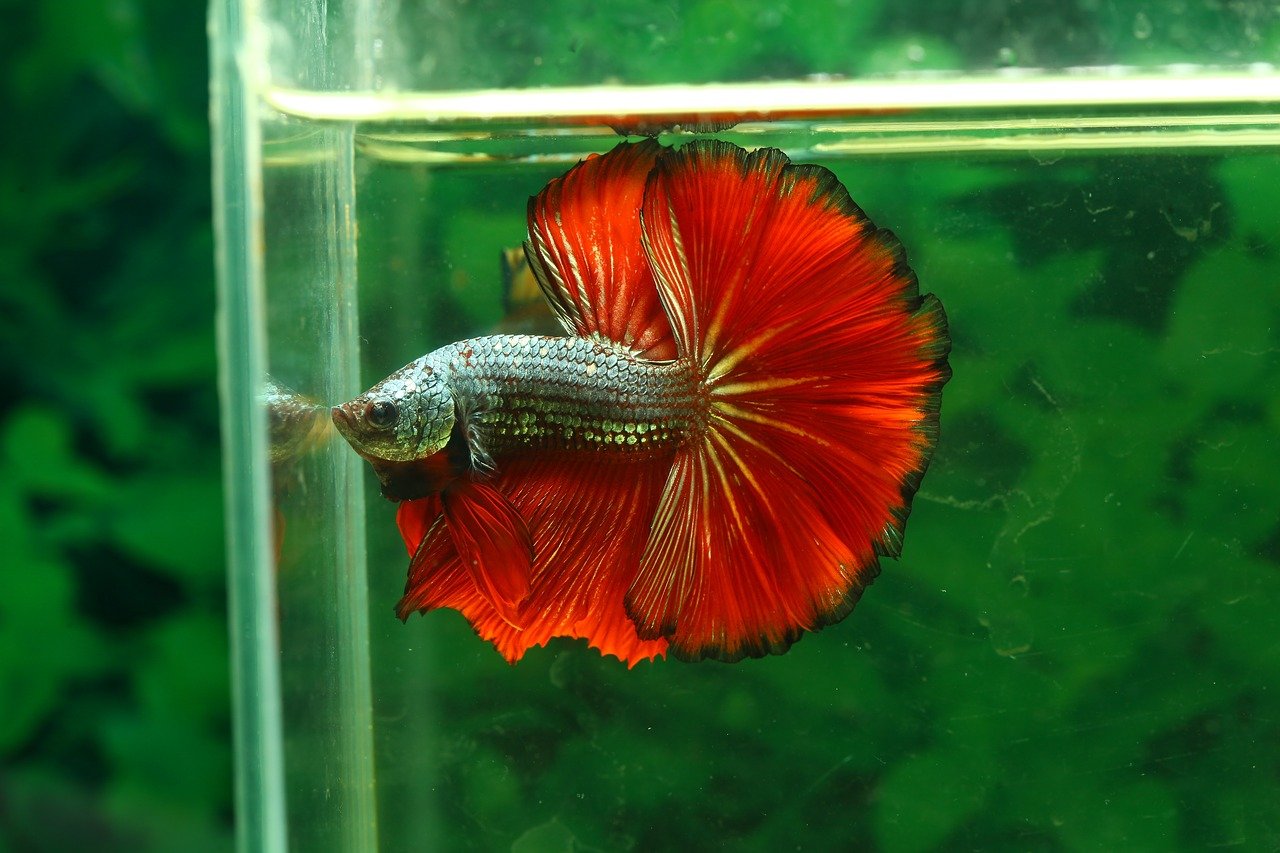
| Care level | Intermediate to Expert |
| Size | 2.5 to 3 inches |
| Lifespan | 3-5 years |
| pH range | 6.5 to 8.0 |
| Temperature | 76-81 degrees Fahrenheit |
| Temperament/Behavior | Peaceful, Can get territorial with same species |
| Alternative names | Siamese Fighting fish |
| Ideal tank size | Minimum 3 gallons |
| Family | Osphronemidae |
Appearance
One of the crucial selling points of this fish is its extravagant appearance. The long flowing fins with the bright orange color accentuate the bowl’s appearance. The male betta fish are brighter in color compared to the female ones. The female variants have shorter fins and have a subdued color.
The unique trait of their appearance is that they become brighter and vivid in color during the mating season.
Habitat
Betta fish is native to parts of Asia, especially around Southeast Asia. You will often find them in marshes, ponds, and the slow-moving streams in the wild.
They typically reside better in the water bodies with low-level oxygen. The fish also has a labyrinth organ, so they breathe in air from the water surface. So, when placing them in a fishbowl without a filter, leave enough space on the top.
Buy a fishbowl with a minimum of 3 gallons capacity. Also, prepare the water and leave it aside a day before you transfer them to the tank/bowl.
Tank Mates
Although they are small and can live in groups, it isn’t ideal for a fishbowl. Since the area is limited, you should start with just one in the bowl.
Since the male bettas get territorial very quickly, you need to avoid keeping same species in one bowl. Some of the best tank mates for them include:
- Cory catfish
- Mystery snails
- Neon tetras
- Ghost shrimp
- Guppies
2. Guppy Fish
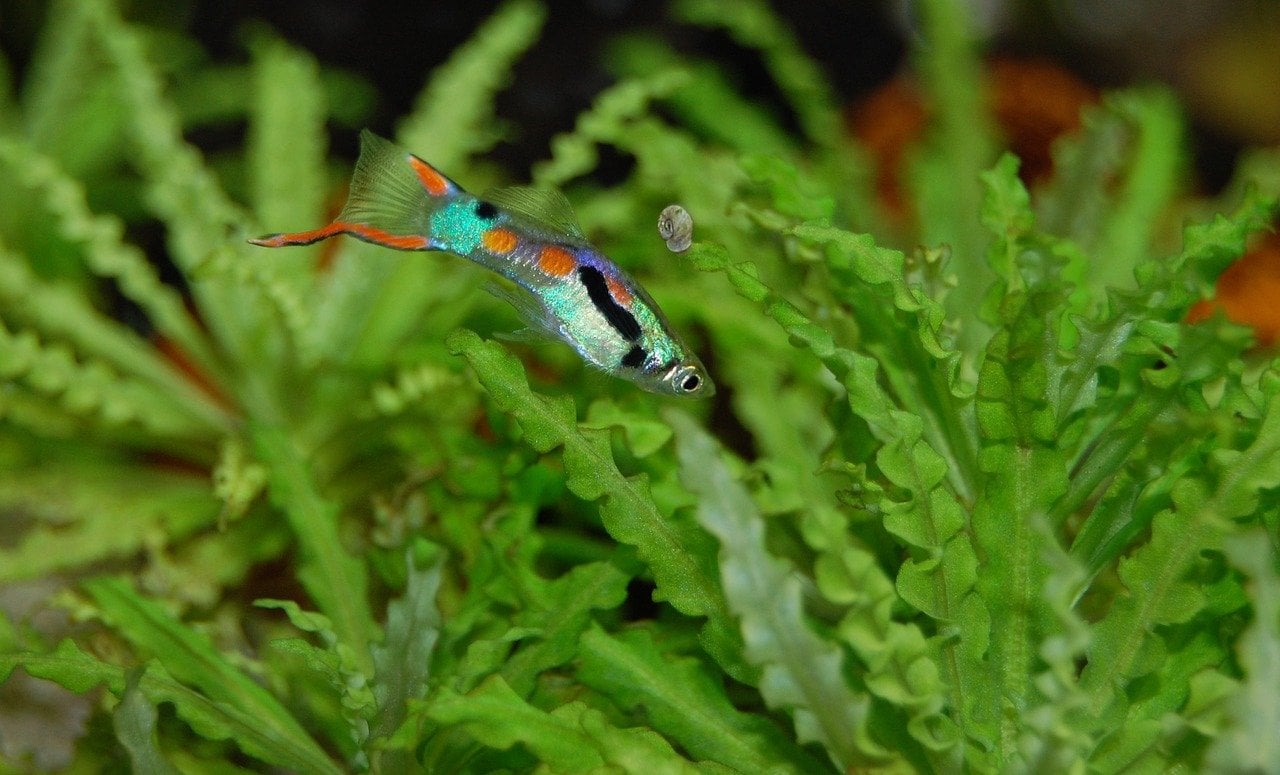
| Care level | Easy |
| Size | 0.5 to 2.5 inches |
| Lifespan | 1-2 years |
| pH range | 5.5 to 8.5 |
| Temperature | 70-82 degrees Fahrenheit |
| Temperament/Behavior | Peaceful |
| Alternative names | Rainbow fish |
| Ideal tank size | 1-3 gallons |
| Family | Poeciliidae |
Appearance
Guppies are one of the few fish species that show sexual dimorphism. Typically, they have a clear and transparent body with color splotches. The female guppies exhibit a dark gray color on their body. The male ones, on the contrary, have spots and stripes.
The female guppies grow longer than the males. The female ones can grow up to 6 cm while the male ones grow up to 3.5 cm.
Habitat
The guppies are native to the northern part of South America. You will spot them in abundance around the Caribbean islands in the wild. Although these fish live in freshwater water bodies, you will also find them lurking away from their natural habitat.
Also, they are extremely hardy fish and can adapt well. However, make sure you clean the fishbowl as instructed and follow the water parameters to keep them safe.
Tank Mates
Guppies are highly peaceful and like to keep to themselves. However, due to their small size, they don’t mesh well with larger fish. So, when keeping them in a fishbowl, pair them with 2-3 more guppies, so they live in peace and harmony.
Some of the best tank mates for guppies include:
- Mollies
- Platies
- Ghost shrimp
- Gouramis
3. Zebra Fish
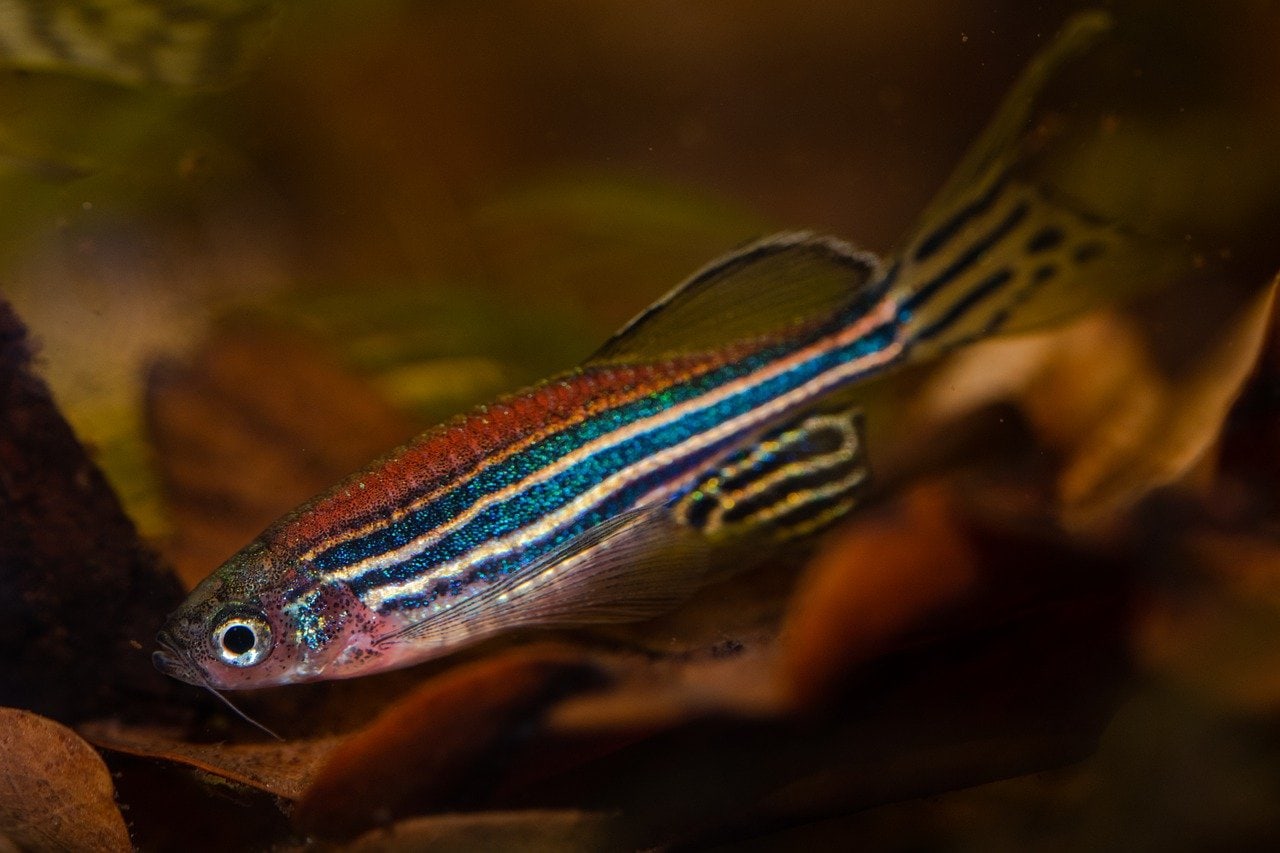
| Care level | Easy to Intermediate |
| Size | 1.6 to 2.0 inches |
| Lifespan | Up to 3 years |
| pH range | 6.8-7.5 |
| Temperature | 78.8 to 83.3 degrees Fahrenheit |
| Temperament/Behavior | Peaceful, Active swimmers |
| Alternative names | Brachydanio rerio |
| Ideal tank size | 1-3 gallons |
| Family | Cyprinidae |
Appearance
Zebrafish undergo a lot of changes to their appearance during their lifetime. These small fish species start with a transparent color to their body during the larval stage. However, as they grow and mature, they start developing strips along the body. Hence, the name. The stripes appear blue and run across the length of their body.
The males have a slender shape to their appearance. Some males even exhibit a pink or yellow color to their appearance, which the females lack.
Habitat
Like betta fish, even zebrafish are native to Southeast Asia. They are sold as Zebra danio in the commercial market. They don’t need filters in captivity due to how they live in the wild.
These small fish tend to prefer living in stagnant water with less current. So, finding them in ponds, streams, and canals is quite common. They do prefer water bodies with balanced vegetation and substrate.
Tank Mates
Zebrafish is peaceful but active. So, when it comes to finding them good tankmates, you want to keep them with idle fish. Pairing them with equally active fish species will make it difficult for them to swim around in peace. They also thrive in shoals.
Some of the best tankmates include:
- Angelfish
- Bettas
- Guppies
- Gouramis
- Loaches
- Swordtails
4. White Cloud Mountain Minnow
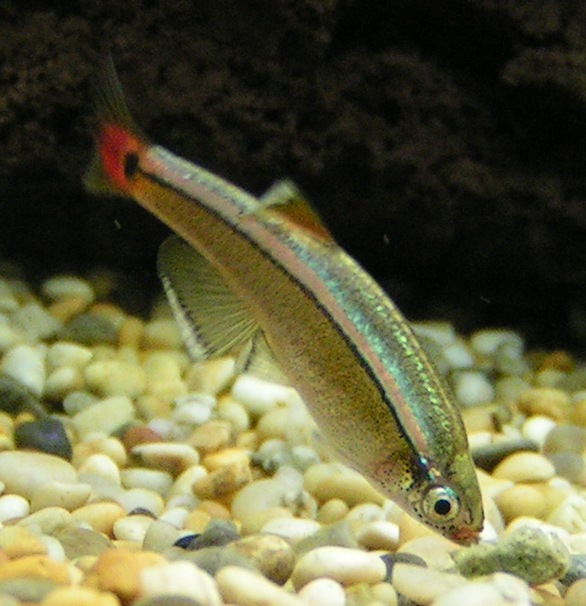
| Care level | Easy |
| Size | 1.5 to 2 inches |
| Lifespan | 5-7 years |
| pH range | 6.0 to 7.5 |
| Temperature | 64 to 72 degrees Fahrenheit |
| Temperament/Behavior | Peaceful |
| Alternative names | Canton danio, Chinese danio |
| Ideal tank size | 2-3 gallons |
| Family | Cyprinidae |
Appearance
The reason why they fit well for a fishbowl habitat is thanks to their extremely small size. They can reach a maximum length of 2 inches, typically stopping at 1.5 inches. The slender and dart-like shape of their body with a shiny silver exterior makes them fascinating to watch. They have specks of orange on their tail and fins too.
The dorsal and ventral fins are shaped like a triangle and help them stream through the water. They do have a very pointed snout.
Habitat
The fish species is native to China, especially found around the Guangdong area. They are found in abundance around the rice fields in China, where they mate and breed.
Besides the marshy areas, they also swim around mountain streams. So, if you want a hardy fish for your fishbowl, this is a prime choice.
Tank Mates
The White Cloud Mountain Minnow is pretty considerate and peaceful. You will find them relaxing in the bottom or the middle of the bowl, keeping to themselves. This nature makes them good tank mates to all small fish species, including:
- Water loaches
- Zebra danios
- Snails
- Ghost shrimp
- Dwarf gouramis
5. Endler’s Guppies
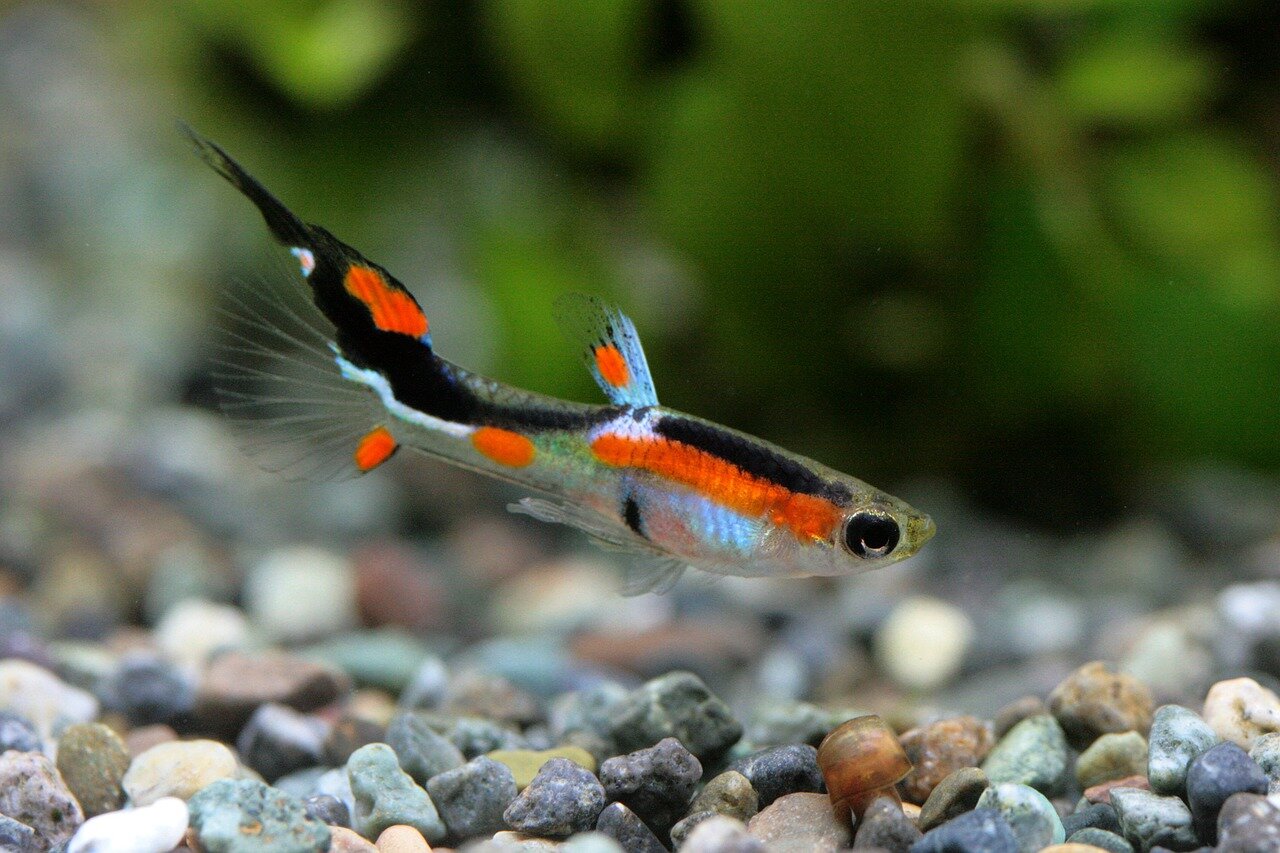
| Care level | Easy to Intermediate |
| Size | Up to 1.5 inches |
| Lifespan | 2-3 years |
| pH range | 7.0 to 7.5 |
| Temperature | 75 to 85 degrees Fahrenheit |
| Temperament/Behavior | Peaceful |
| Alternative names | Poecilia wingei |
| Ideal tank size | 3-5 gallons |
| Family | Poeciliidae |
Appearance
The appearance of this fish varies. The male ones are the vibrant and slender-looking ones with bright patches of color on their body. The female ones, on the other hand, are plain. The female variants have the staple shades of silver and gold on the body.
Also, since the female Endler’s guppies are livebearers, their abdominal region is round and swollen. The male ones have a slender and long body, while the female ones mimic an oval. The livebearer males have a blend of bright orange, black and metallic shades to the body.
Habitat
Endler’s guppies are quite rare and are native to Venezuela. They are found in water bodies with shallow water content at around 15 cm depth in the wild. Besides that, they are commonly found in the water with a greenish hue to them.
They are surrounded by vegetation, often from the dead leaves that fall into the water from the nearby trees. Since they are not found in abundance in various places, their wild population is under threat at the moment.
Tank Mates
Endler guppies are quite peaceful. Typically, they need to stay in groups and can’t survive well alone in the fishbowl. Since they are smaller in size, you don’t want to pair them with larger fishes because they will be a meal.
Instead, pair them with same-species or with smaller fishes like:
- Cherry barb
- Dwarf gourami
- Emperor tetra
- Kuhli loach
- Panda cory
- Swordtail
- Rosy bard
6. Dwarf Pufferfish
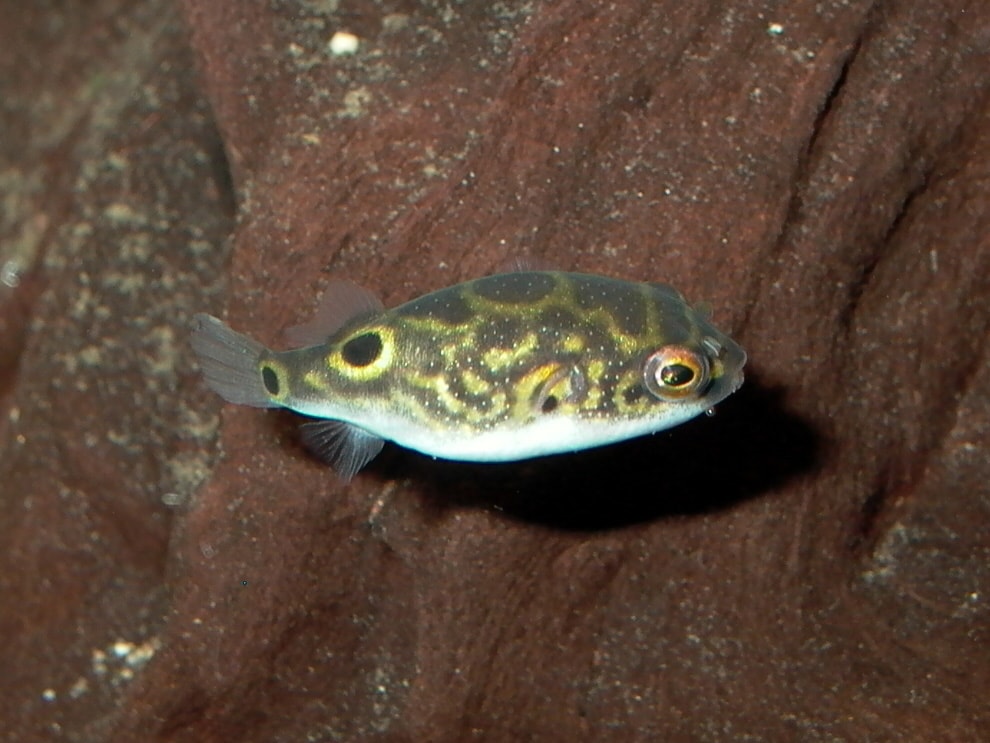
| Care level | Intermediate to Experienced |
| Size | Up to 1.5 inches |
| Lifespan | Up to 4 years |
| pH range | 6.5 to 8.5 |
| Temperature | 74 to 82 degrees Fahrenheit |
| Temperament/Behavior | Territorial, can get aggressive with other fishes |
| Alternative names | Malabar pufferfish |
| Ideal tank size | 5-10 gallons |
| Family | Tetraodontidae |
Appearance
Pufferfish has gained a lot of popularity over time, especially due to its appearance. They are typically small in size and have a more yellow tinge to their appearance. They have dark green to black patches around the dorsal fin and the surfaces.
Also, sexual dimorphism is quite apparent in these fish species. The male variants, like several other species, are more vibrant and colorful than the female ones. The fish has a tapered structure with a bulbous head in the front. They also have distinct colors on their body to distinguish them from the toxic elements in the wild.
Habitat
The dwarf pufferfish is native to the province of Kerala and southern Karnataka in India. They are profoundly available in the wild, especially in 13 different rivers across Kerala.
As for their staple habitat, you will find them in the subtropical and tropical ocean waters. The species is found in abundance in freshwater and brackish water bodies.
Tank Mates
Dwarf pufferfish is not the most pleasant and down to Earth species you will find. So, if you plan to keep them with any standard fish in the tank, you need to think again.
Since they are quite territorial, you need to be careful about the tank mates you put them in. However, if you don’t want to deal with the hassle of tank mates, they work well alone too.
Some of the ideal tankmates for the fishbowl include:
- Ember tetras
- Mosquito rasboras
- Neon tetras
- Filament barbs
- Leopard danios
7. Pygmy Corydoras
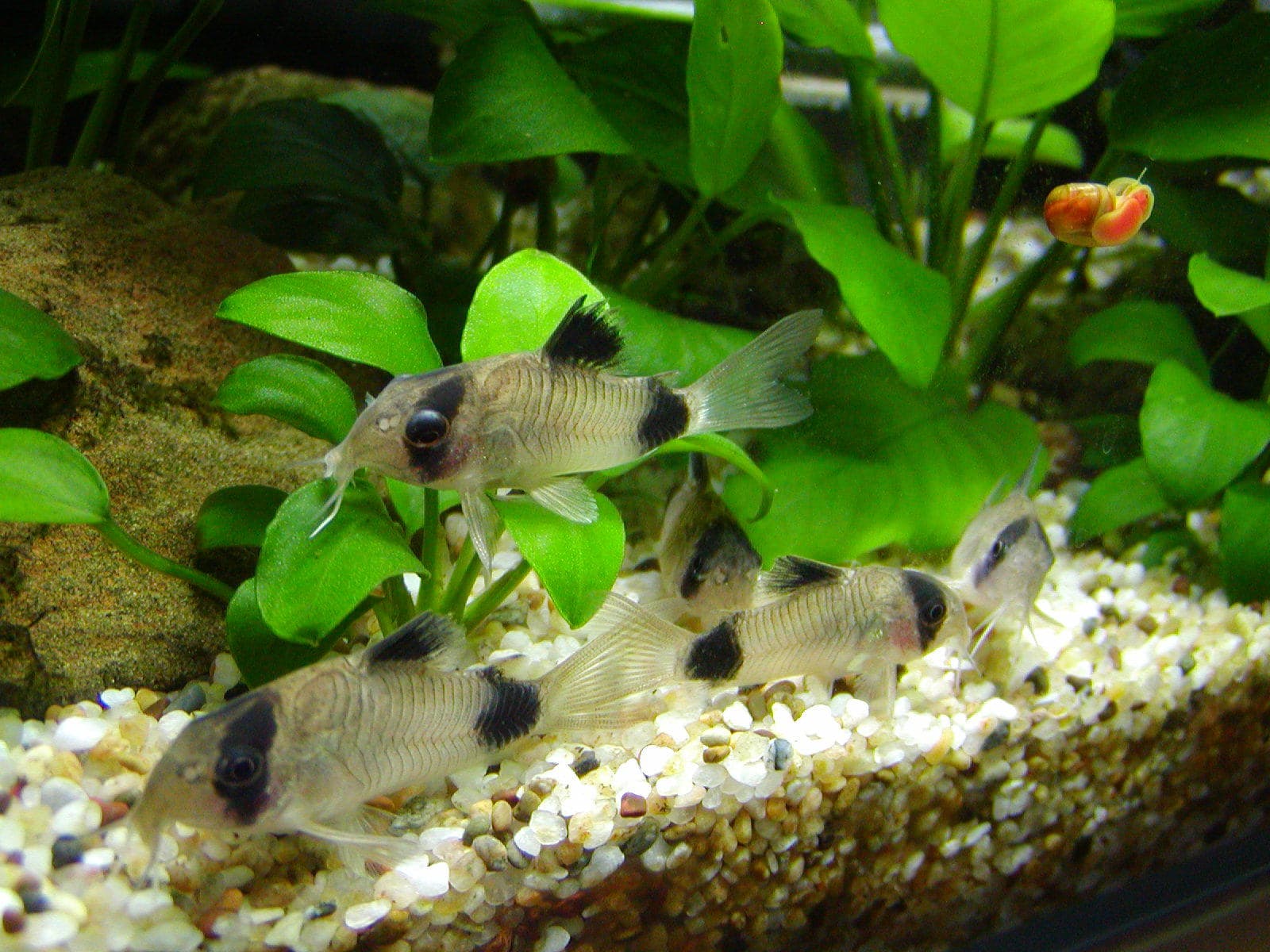
| Care level | Easy |
| Size | 1.2 – 1.5 inches |
| Lifespan | 2-3 years |
| pH range | 6.4 to 7.4 |
| Temperature | 72 to 79 degrees Fahrenheit |
| Temperament/Behavior | Peaceful |
| Alternative names | Pygmy Catfish |
| Ideal tank size | 10 gallons |
| Family | Callichthyidae |
Appearance
If you have seen Corydoras Catfish, be aware that Pygmy Corydoras look more or less similar. The only difference between the two is their size. They have distinct black stripes and belts throughout the length of their body. They also have a distinct black spot on their tail that distinguishes them from the rest.
The reason why they typically work well in fish bowls is due to the small size. However, they also need round-the-clock care when kept in a fishbowl.
Habitat
This form of Catfish is typically native to Brazil, especially found in the Madeira River. Besides Brazil, the species is also found in Peru and Ecuador. But what you need to realize is that they require high vegetation areas to strive in. They also live in tropical climates, so you need to mimic the same in captivity too.
Tank Mates
Typically, Pygmy Corydoras is a peaceful fish species. When looking for ideal tank mates, they need to be paired with fish species of similar or smaller sizes. Also, they pair well with fish species that lurk around in the middle or the upper part of the aquarium.
Some of the best tank mates for this species include:
- Dwarf gouramis
- Zebrafish
- Neon tetras
- Mollies
- Cherry barbs
8. Sparkling Gourami Fish
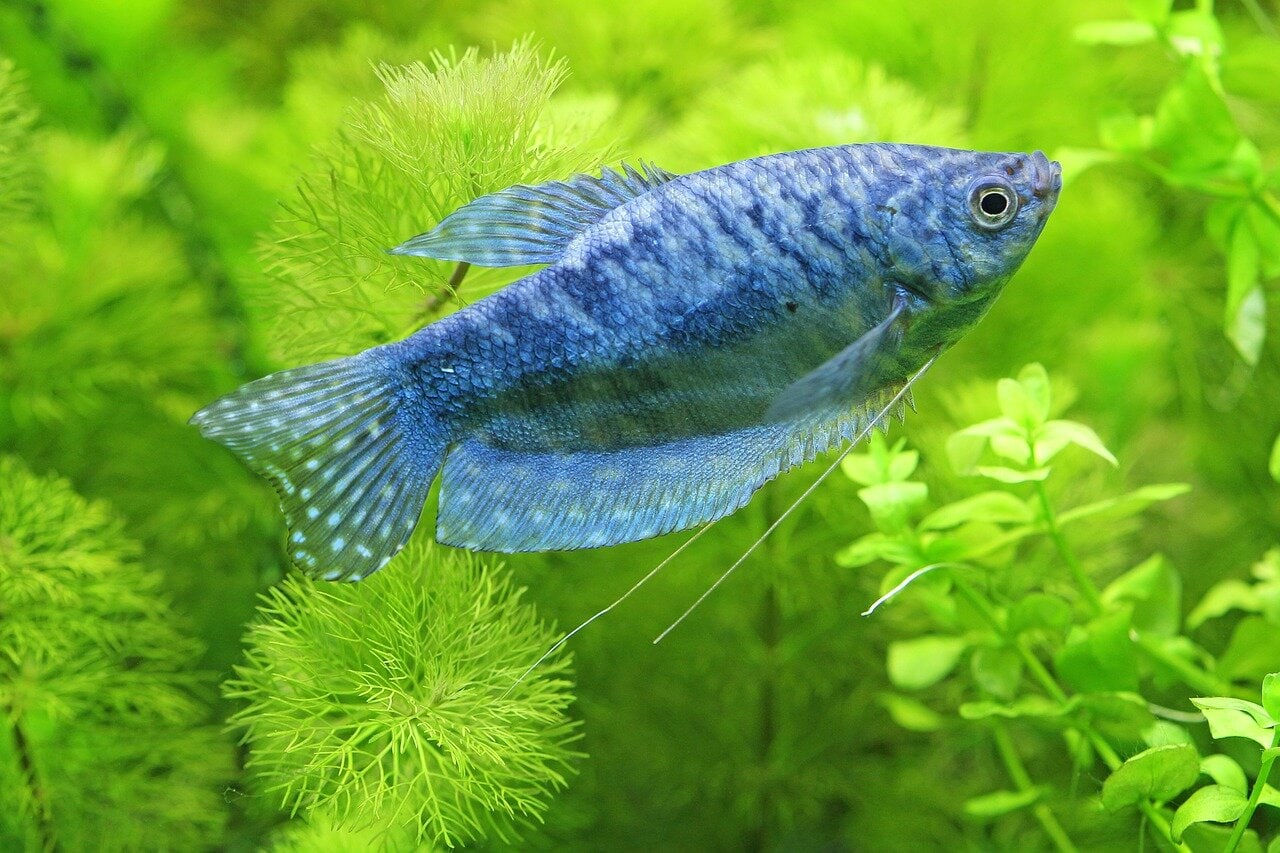
| Care level | Easy |
| Size | Up to 1.5 inches |
| Lifespan | 4-5 years |
| pH range | 6.0 to 7.0 |
| Temperature | 76 to 82 degrees Fahrenheit |
| Temperament/Behavior | Peaceful |
| Alternative names | Pygmy gourami |
| Ideal tank size | 10-15 gallons |
| Family | Osphronemidae |
Appearance
If you are particularly looking into getting a fish species that don’t need a filter, sparkling gourami is a good option. It is an extremely small aquarium fish and fits right into the fishbowl you have around.
The fish has a murky brown color to its appearance with distinct blue spots on the body. Sparkling gourami has a shiny finish to their body, hence the name. Despite their size, the fish is quite active and will move around the tank in zooming motions.
Habitat
The sparkling gourami is native to different provinces of Southeast Asia. They are found in water bodies with stagnant water and in rice fields too. Since they are found in slow-flowing water, you can keep them in fishbowls with proper oxygenation.
Tank Mates
Since this species is quite peaceful, it isn’t surprising that they mesh well with other small and peaceful fishes. Just avoid keeping them with larger species that show signs of aggression.
Some of the best fish species as tank mates include:
- Dwarf pencil fish
- Dwarf rasboras
- Dwarf suckers
- Neon tetras
How to Choose a Fish Species that Don’t Need Filter?
Now that you know of a few fish species that stay healthy in fish bowls, it is time to look into the care instructions. Be aware that despite what you read, fish do need the right care. Although you can skip out on the filter, you still need to provide the fish with the right living conditions.
So, how should you care for a fish species that don’t need a filter?
Following are the key pointers:
Opt for a hardy fish
It isn’t even a question that you need a hardy and high-quality fish for a filter-less fishbowl. The lack of a filter means the waste accumulation will be pretty high. So, you need to keep up with optimal care to ensure the optimal health of the fish.
Besides hardy fish, you also need to look out for cold-water fish species. The reason why we prioritize this is because they strive even with temperature fluctuation. Coldwater fish species also don’t require very frequent water change, which is a benefit.
Look out for a good design of the fishbowl
Another factor worth considering is the shape and size of the fishbowl. Depending on the fish type, you want to leave enough space for each fish with optimal oxygenation.
Make sure you leave each fish with enough space so they can zoom around comfortably in the tank. Even for the lone and peaceful fish, you need to leave them enough space in the tank for proper aeration.
Focus on water changes
Without a filter in the tank, the biggest concern is with the accumulating waste in the tank. When you are a beginner, you want to choose a smaller fish that fits comfortably in the tank.
For water changes, do it every 5-7 days to prevent water-borne infectious diseases. Don’t assume that just because they are hardy, they will sustain dirty and murky water. Clean water also reflects proper oxygenation in the tank.
Also, with fish bowls, you won’t have to worry about changing all the water. A 30-50% water change often does the trick. In case you aren’t very experienced, using a water conditioner can do the trick too.
Be wary of the substrate
Just because you are using a fishbowl doesn’t mean you won’t need substrate. On the contrary, you need a good and level substrate to ensure the optimal health of the fish. You can also mimic the bacterial breeding ground by adding sand, gravel, or plants to the fishbowl.
But, if you are adding any substrate to the fishbowl, make sure you quarantine them for some days first. If your fishbowl isn’t working without a filter at all, adding a sponge filter can help.
Be mindful of aquarium hygiene
Not just the water changing, fishbowl hygiene is equally important. You need to collect the dirt from the bottom, clean out the dead plants to ensure optimal health of the fish.
Even without a filter, you need to prioritize aquarium hygiene. If required, get a long stick to reach the less accessible areas in the tank.
Conclusion
The concept of keeping a fish without a filter can seem too farfetched. However, with the right tricks and proper hygiene, it is quite feasible. All you have to do is be mindful of the species you are choosing and the care you are taking.
Sometimes, all you need to do is take care of the species the right way. If you are new, work on your fish-keeping skills to ensure optimal setup.
We hope this article gives you all the insights that you are likely looking for. Make sure to leave us a comment in case there are any more questions.
No related posts.
